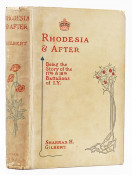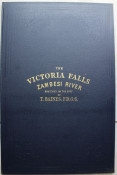(these 4 volumes are located in the USA)
LAKE NGAMI
London, Hurst & Blackett, 1856
Charles John Andersson's first book, LAKE NGAMI, was published in London in a beautiful and expensive edition, but the American first edition published by Harper was less impressive in every way. This Hurst & Blackett London edition has been rebound by hand (so expect imperfections, not machine-perfect results) in dark brown soft full leather.
The pages are largely free of foxing, which is uncommon for a book that was published in London. A few pages have had professional repairs to edges, and the large folding map is a professionally-reproduced facsimile.
THE OKAVANGO RIVER
Harper, New York, 1861. First edition, first printing
Rebound in full leather, but the original book was well-read and has signs of much use. The map is missing 2/3, but a facsimile is supplied, as well as a facsimile of one of the illustrations (see the photo of the elephant uprooting a tree).
THE LION AND THE ELEPHANT
Facsimile reprint of the 1873 Hurst & Blackett, London, First Edition: bound by hand in half-leather, marbled end papers.
NOTES OF TRAVEL IN SOUTH AFRICA
Facsimile reprint of the 1875 Hurst & Blackett, London, First Edition: bound by hand in half-leather, marbled end papers.
The original first editions are rare, so these facsimile reprints are the next best thing.
------------------------------------------------
Karl Johan Andersson was born on 4 March 1827 in Sweden. He was the illegitimate child of the British bear hunter Llewellyn Lloyd and Lloyd's Swedish servant.
Andersson grew up in Sweden. Early in his life he went on hunting expeditions with his father, experienced Swedish nature and started a collection of biology specimens.
In 1849 he departed for London, intending to sell his collection to raise money for travels around the world. In London he met with the explorer Francis Galton, with whom he organised an expedition to Southern Africa. On midsummer day in 1850 they arrived at the Cape of Good Hope and then travelled to Walvis Bay, in modern-day Namibia. They then trekked into the interior, at the time little explored by Europeans. They intended to reach Lake Ngami, but failed on that expedition.
Galton returned home to England, while Andersson stayed in the area and reached Lake Ngami in 1853. In 1855 Andersson returned to London, where he published his first book LAKE NGAMI, in which he describes his travels. He returned to Africa the same year.
Back in south west Africa, Andersson was hired as manager for mines in what was then called Damaraland and Namaqualand. However, he only held the position for a brief time, and continued his explorations. In 1859 he reached the Okavango River, an expedition that he recorded in his book THE OKAVANGO RIVER.
After his return, he travelled to the Cape, where he married. Andersson and his wife settled in Otjimbingwe (in modern central Namibia).
Andersson had repeated financial problems. Even though his main interests were exploration and natural history, he often needed to earn money through trade and hunting. He lacked the money needed to publish his books and Galton declined to lend him any.
Andersson ultimately launched several ventures in Damaraland, including a copper mining scheme. He was briefly elected Chief of the Damara in 1864, but he was severely wounded in battle against the Nama Hottentots.
In 1867, despite serious illness due to his battle wound, Andersson travelled north towards the Portuguese settlements in modern Angola, in order to establish a better trading route to Europe. He was unable to cross the Cunene River, so he had to turn back. His condition had worsened during his journey to the Cunene and, on the return journey, he died on 9 July 1867. He was buried by another Swede, Axel Eriksson.
After his death, Andersson's wife and children continued to live in Africa, in the Cape Colony.
Posthumously, Andersson's father, Lloyd, published notes from some of his son's exploration and hunting expeditions in the book THE LION AND THE ELEPHANT, as well as Andersson's last book, NOTES OF TRAVEL IN SOUTH AFRICA.
Andersson is "perhaps the most extraordinary visitor to Namibia in the 19th century" (Tonchi, p. 24),
It has also been said of Andersson: "Few, if any, [explorers] give so full and complete an account of Namaqualand, Damaraland, and the Ovampo country and the description of the fauna of these countries is absolutely unequalled." (Mendelssohn). "A cornerstone book of African hunting in the middle of the nineteenth century." (Czech)




















































































